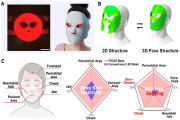Some LEDs made from perovskite emit light over a broad wavelength range. To further explain the feature, scientists from the University of Groningen inspected some cases and proposed new explanation which may help other scientists to design perovskite LEDs capable of broad-range light emission. The study was published in the journal Nature Communications on May 11, 2020.
Low-dimensional (2D or 1D) perovskites emit light in a narrow spectral range and are therefore used to make LED of superior color purity. However, in some cases, a broad emission spectrum at energy levels below the narrow spectrum has been noted. This process has attracted great interest as it could be used to produce white light LEDs more easily compared to the processes that are currently being used. To design perovskites for specific purposes, however, it is necessary to understand why some perovskites produce broad-spectrum emissions while others emit a narrow spectrum.

(Two perovskite flakes with different photoluminescent colors; image: Loi lab, University of Groningen)
Quantum confinement
Perovskites are a versatile group of materials with a very distinctive crystal structure, known as the perovskite structure. In hybrid perovskites, the cations are organic molecules of different sizes. When the size exceeds a certain dimension, the structure becomes two-dimensional or layered. The resulting quantum confinement has large consequences for the materials' physical properties and, in particular, for the optical properties.
Emissions
Maria Lio, Professor of Photophysics and Optoelectronics at the University of Groningen, noted that a broad low energy spectrum is commonly regarded as an intrinsic property of the material. However, observations made in Loi's laboratory appear to contradict this theory. Simon Kahmann, a postdoctoral researcher in the team, indicated, 'One of our students studied single crystals of a lead-iodide-based 2D perovskite and noticed that some crystals emitted green light and others emitted red light. This is not what you would expect if the broad red emission were an intrinsic property of this material.'
Color
The research team proposed that defects in these perovskites could change the color of emitted light. Therefore, they decided to test the mainstream interpretation with an ad hoc experiment.
Using laser light of different colors, and therefore of different energies, they studied the emission of the crystals. They found that when we used photons below the bandgap energy, the broad emission still occurred, which does not meet the mainstream interpretation.
Consequences
Their explanation is that a defect state with an energy level inside the bandgap is governing the broad emission and the large color variation of the crystals. 'We think that it is a chemical defect in the crystal, probably related to iodide, which causes states inside the band gap,' said Kahmann. Thus, the broad emissions are not an intrinsic property of the material but are caused by an extrinsic effect.
This finding has profound consequences for scientists to predict new and better compounds that broadly emit light as they move a step toward to understanding the origin of this emission.
The new explanation of perovskites LED from the University of Groningen now shows that the broad emission in 2D lead iodide perovskites is not an intrinsic property of the material. This means it is not very efficient. This means that optical investigations of this class of materials should be interpreted with care.





 CN
TW
EN
CN
TW
EN






